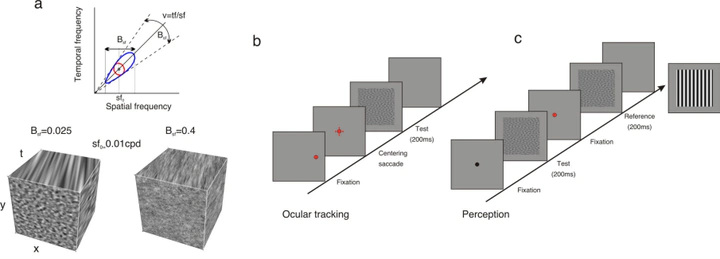Pattern discrimination for moving random textures: Richer stimuli are more difficult to recognize

Abstract
In order to analyze the characteristics of a rich dynamic visual environment, the visual system must integrate information collected at different scales through different spatiotemporal frequency channels. Still, it remains unclear how reliable representations of motion direction or speed are elaborated when presented with large bandwidth motion stimuli or natural statistics. Last year, we have shown that broadening the spatiotemporal frequency content of a textured pattern moving at constant speed leads to different results on a reflexive tracking task and a speed discrimination task. Larger bandwidth stimuli increase response amplitude and sensitivity of ocular following, consistently with a maximum-likelihood (ML) model of motion decoding. In contrast, larger bandwidth stimuli impair speed discrimination performance, suggesting that the perceptual system cannot take advantage of such additional, redundant information. Instead of ML, a gain control decoding mechanism can explain the drop in performance, suggesting that action and perception rely on different decoding mechanisms. To further investigate such task-dependant pooling of motion information, we measured pattern discrimination performance using these textured stimuli. Two noise patterns were presented sequentially for 250 ms on a CRT monitor (1280 × 1024 @ 100 Hz) and covered 47$,^∘$ of visual angle with identical properties (mean SF, bandwidth SF, speed) except for a randomized phase spectrum. A test pattern was then presented and subjects were asked to match it with one or the other reference stimulus (ABX task). At small bandwidth and optimal mean spatial frequency (0.3 cpd), subjects were able to discriminate the two patterns with high accuracy. Performance dropped to chance level as spatial frequency bandwidth increased. Increasing the mean spatial frequency decreased the overall performance. Again, these results suggest that perceptual performance is deteriorated in presence of larger information.